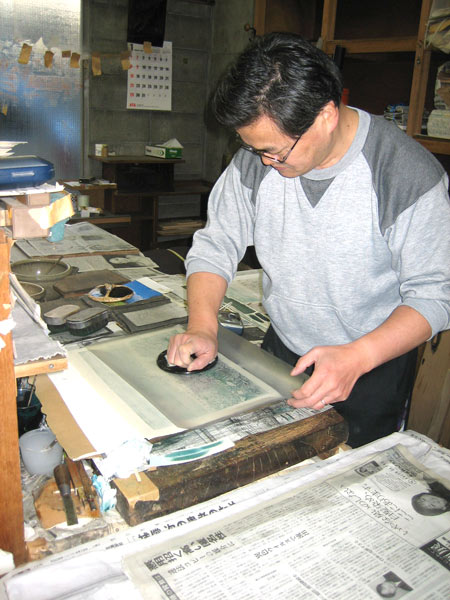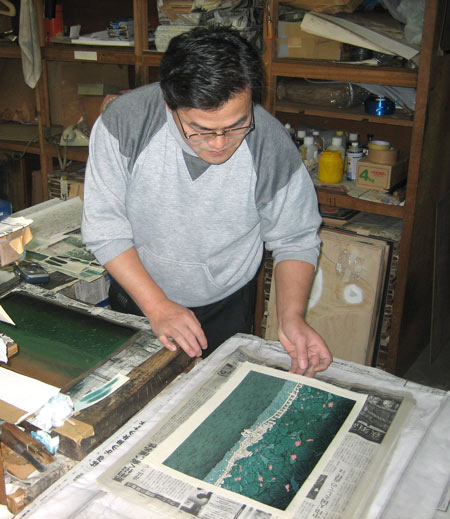Visit to ... Numabe-san, the printer
Mr. Shinkichi Numabe
Back in the early days of this Hyakunin Issho newsletter, a feature that appeared a number of times each year was a report of a visit to one or another of the craftsmen working in this field. I visited not only carvers and printers, but craftsmen working 'behind the scenes', the people who provide the tools and supplies needed for making woodblock prints.
In recent years I seem to have let that series lapse; I suppose partly because I have felt less need to visit other craftsmen for advice on my work. But with the startup of my new Mokuhankan publishing venture, I have found myself again in contact with other workers, and that provides a perfect excuse to get that series up and running once more!
All of the men I wrote about in those earlier issues were quite a bit older than me, but we'll bring things back into balance with this report; today's craftsman is my contemporary - we were born just two months apart!

When I heard printer Shinkichi Numabe tell me about how he first got interested in woodblock prints, I had to do a double take - it was so similar to my own experience! In my case it was a random meeting with some prints on display as I walked down a street in Canada; in his case he popped into a department store for a quick bit of shopping, and came across a display of prints. For both of us, the chance encounter led to a complete change in life direction.
Just prior to that encounter, Numabe-san had spent a couple of years at an 'Art Institute', but was finding - of course - that making a living in the art field presented severe difficulties. What he saw in the department store that day though, opened the door to something new, because the prints weren't just on display, there was a craftsman there demonstrating the process. Having done plenty of demonstrating myself, I can easily imagine what must have happened that day. When you are sitting there printing in public, most people stop and watch for a minute or so, and then wander on. A few people stand and watch for a bit longer ... and then wander on. But every now and then somebody comes along who stands and watches, perhaps starts to move on, but who then hesitates a bit ... stays to watch a bit longer ... and then a bit longer. Something has 'caught' their attention, even though they could probably not explain exactly what it is. It might be the attractive colours on the sheets, perhaps the smooth and relaxed movements of the craftsman, perhaps the curious contradiction of such glorious results appearing seemingly by magic from such a simple process.
In any case, Numabe-san was hooked. Nakajo-san, the printer that day, introduced him to a workshop where he was able to work as a trainee for a while, and then, after enough time there for Numabe-san to show that he was going to stick with this, took him under his own wing for more extended training as an apprentice.
In the early stages of learning this craft, it is impossible to produce work that will 'pay its way', so Numabe-san worked at various part-time jobs while developing his printing skills. But because he was a person who had come to this by choice, and not by being 'sent' to the trade, his skills developed rapidly, it was not long before he was standing on his own feet, and he has now become one of the most respected printers in Tokyo.

A major difference between Numabe-san and myself is that while I do only work that I myself have selected, he is a 'printer for hire' and thus over the years has accumulated an incredible amount of experience with every possible kind of woodblock printing: traditional and modern, small and large, and simple and complex. And the years of working side-by-side with men such as Nakajo-san and later, Komatsu-san, was a wonderful chance for him to absorb and learn from their long experience. His reservoir of skills is far wider than mine, and every time I drop down to visit his workroom I end up learning something useful for my own work. (This is not completely a one-way street, as I have a pretty good repertoire of techniques that I have developed independently, so we always have plenty of things to share during our meetings!)
Far and away the bulk of the work that Numabe-san sends from his bench is 'anonymous'; the publisher sends him a set of blocks, he pulls an edition, and the prints - which almost never carry Numabe-san's name - are then sold by the publisher. When I approached him to do work for my Mokuhankan project, I told him that wherever possible (in the case of prints that had margins), I want to put the craftsmen's names on the print. He certainly didn't demand this, but neither did he reject the idea; I think that, like me, he is quietly proud of his skills, and would like to think that the presence of his name on the margin of a print would come to be seen as a mark of a well-made product.
If you were able to listen in to our business discussions, where we 'bargain' back and forth about the fees, etc. for the Mokuhankan printing jobs, you would probably shake your head. Instead of what you might expect - the publisher trying to drive the printing costs down as low as possible, and the printer trying to get as much as he can - we are both so concerned about the 'other guy', that we sometimes end up bargaining in reverse! I need this guy to be successful, and happy about his work. And he needs the publisher to be successful, and happy to use his services.
Most of the newly-produced woodblock prints I see these days are evidence of a different approach - cheap paper, and quick and rough work, all in the name of 'keeping the price down'. But Numabe-san and I haven't come this far building up our skills only to let them go to waste that way. We're not in this for yen and dollars, we're in this for the pleasure of seeing beautiful prints come off our workbench. The money will take care of itself somehow ...
He and I are both 55; so there should still be plenty of time for quite a nice pile of prints to get done before we have to hang up our barens! I'm looking forward to many years of working together!

